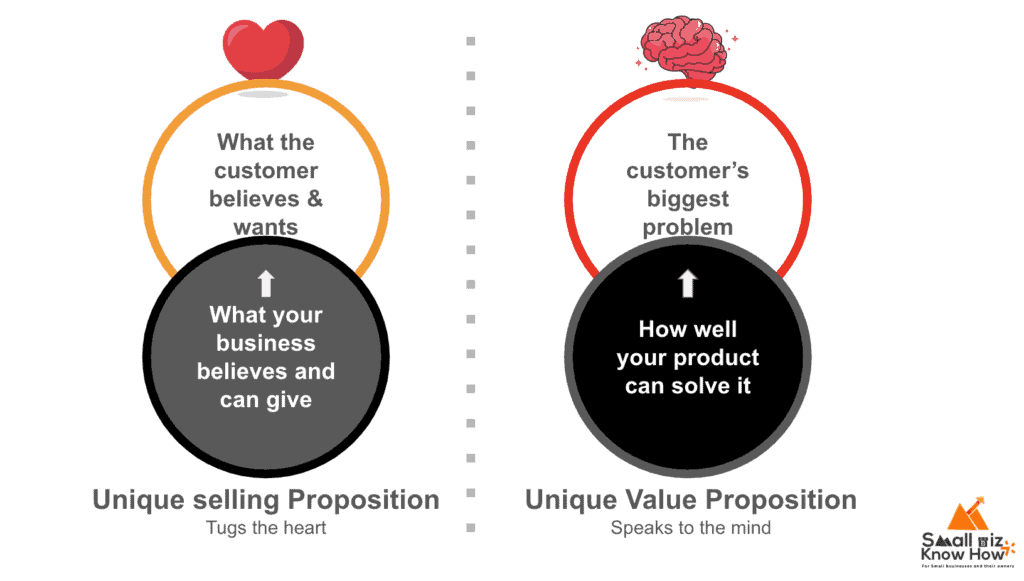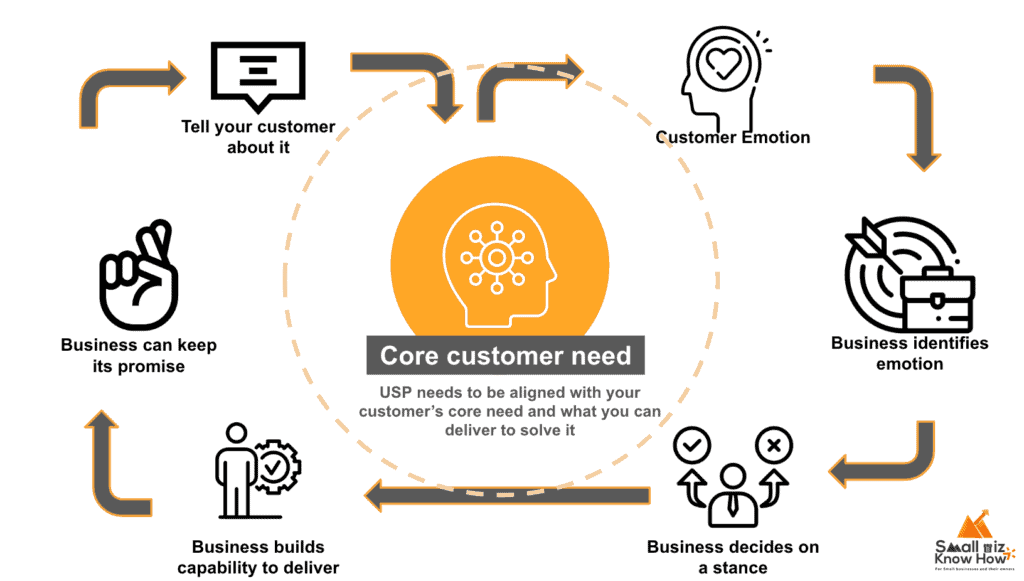Many times, small business owners confuse the unique selling proposition with what is unique about their product or product feature. Business owners sometimes have ‘blinders’ on and think ‘product’ backed to communicate what is unique about their product.
What is missed out is often the ‘customer feeling’ that should evoke. A unique selling proposition is supposed to entice and evoke an emotion in your customers that aligns with what is unique to what your product offers.
A unique selling proposition is what helps a small business remain consistent as they try to build their brand and position it to the relevant target customers.
Lets look a short fictitious story to highlight this: Sweet Wheat’s heartfelt transformation

In a small touristy town, two bakeries stood side by side: “Sweet Wheat” and “Magic Dough.” Sweet Wheat, a family-run business, had always prided itself on its traditional baking methods, while Magic Dough had carved out a unique niche with its gluten-free offerings.
Emily’s Challenge: Emily, the owner of Sweet Wheat, saw a slow down in her business growth when compared to Magic Dough. Despite having a loyal customer base, she realised her bakery lacked a clear unique selling proposition, something that would make new customers drawn in and to choose Sweet Wheat if their preferences were to have traditional home-made style pastries.
Observing the Competition: Her neighbour, Magic Dough was thriving. Lucas, its owner, used the unique selling proposition of health and wellness to attract a specific customer demographic of younger more ‘aware’ crowd who preferred gluten-free and health conscious options. Emily understood that to differentiate her business, she needed a unique selling proposition that would not only set her apart but also create an emotional bond with her customers.
There was enough room for both businesses to bloom, but one communicated clearly what they stood for, while Emily, not so much.
The Journey to Find the USP: Emily began to explore the deeper desires and emotions of her target customers. She engaged in conversations with loyal customers and listened to their stories. She realised that her bakery was more than just a business to them; it was a part of their community, their memories and had a place in their day-to-day life.
Crafting the Emotional USP: Inspired, Emily crafted Sweet Wheat’s unique selling proposition:
“Warm Memories, Local Charm: Relish the Love in Every Homemade Bite, Crafting Grandma’s Priceless Recipes Everyday”.
This USP was designed to evoke feelings of warmth, nostalgia, and a sense of belonging among her customers. She wanted her business to be seen as a haven of comfort of home-made food through her baked goods.
Implementing the Change: With this new unique selling proposition, Emily revamped Sweet Wheat’s brand positioning to target those Lucas was not targeting.
She brought to life stories of her family recipes, the local ingredients she used, and how each pastry was a piece of home. This brought her customers who wanted homely creations and tradition fare and helped in creating a strong emotional connection.
The Result: As a result, Sweet Wheat’s business saw consistent growth and word spread. Customers were not just buying pastries; they were buying into an experience, a feeling of home and tradition.
Why should every small business owner work hard to get their Unique Selling proposition (USP) right?

Now that you looked at a fictitious case study of why a unique selling proposition matters, lets look at why this is an extremely critical strategic activity that small business owners need to undertake.
A unique selling proposition tugs at the emotional chords of the customer and they know instantly that the product is for them
When you are doing a brand building exercise, as a small business, you must be absolutely certain about who is the customer you want to serve. You cannot serve everyone. Your unique selling proposition helps you achieve just that.
A USP immediately attracts the right customer’s attention
Assuming that you have worked to build the ideal customer persona, your USP is the shortest way to communicate what your business stands for to your ideal customer and get their attention. Getting attention of the right customer is the first step in building that relationship
A USP is like an elevator pitch where you have 60 seconds to impress and hook the right customer and immediately shut out those you are not targeting.
A USP tells the world what you stand for and confirms that you are unique
Taking a stance in public is something that many people want to avoid doing since it comes with shouldering responsibility for what you say. But, this is what makes your brand stand out and get attention from those who align with what you say.
There will be naysayers, there will be people who disagree and criticise, thank them and tell them that your product is not meant for them. It takes guts and a solid conviction in your beliefs to take a stance and defend it.
What is the difference between the unique selling proposition and a unique value proposition?

A unique selling proposition brings an emotional connect with your product and how its different and perfectly suits your target customer whereas a unique value proposition goes into the virtues of the product that your business sells and how it adds value to the customer’s life.
A unique selling proposition is a very short almost slogan-like statement that is meant to get the attention of your target customer that helps them get hooked to your brand since it resonates with their beliefs. It has a touchy-feely purpose and is meant to speak to the customer’s emotions or heart.
The unique value proposition, brings in the quantification of value that the customer gets when he or she buys your product. Its basically the value of the uniqueness or difference that your product has versus others in the market. UVP is measurable and can help rank your product versus the competition in the broader market.
The unique value proposition speaks to the customer’s logic or mind and aids rational decision making.
Having your unique selling proposition and unique value proposition in sync and complementing each other will tug at the customer’s heart and mind and really make for a compelling case
What are the pre requisites for a small business to create a unique selling proposition?

By now, I hope that I have brought you to the table where you are willing to try and make a unique selling proposition for your business. However, as a business owner, you must realise that a USP is not merely a slogan. It is the essence of what your business stands for.
While getting ready to put out your USP in public, you must make sure that you are ready as a business to deliver on your claims.
Brand Positioning is critical to driving your unique selling proposition
The essential element of marketing strategy is branding and within branding is the brand positioning strategy for your business, without which none of your marketing elements will fall in place. Before you go about preparing your USP, having your brand positioning in place is critical because of the following reasons.
- Your brand position will help align your USP with customer expectations
- It helps position your brand in the mind of the customer with the right target audience
- It becomes the guiding factor for all marketing strategy and communication for your brand
- It sets the foundation for the kind of emotional connection you seek to establish with your customer for your brand
Your product should solve the biggest pain point for your target customer before you put forth your unique selling proposition
This is a point that everyone mentions all the time and at the same time its also the most mis-understood point as well.
As a business, you have identified your customer’s pain point which is the source of problems. The second level thinking needed here is asking “Is this pain point that I have discovered really a big pain for the customer?”.
There is no point in solving for a pain-point which is not that big an issue for the customer. Getting this nuance right will help you in positioning your brand correctly for the customer for whom the pain that you are solving is the biggest problem in his or her life.
Your USP should then be defined in such a way that it immediately and directly attacks to solve this biggest pain point for your customer.
A good selling proposition should also align with your business’s marketing strategy
A good USP should be omnipresent across all your marketing initiatives. Thats when you can really say that your USP is in alignment with your business marketing strategy. There some practical ways in which you can ensure that this happens.
- Make sure that the USP captures the unique interests, aspirations and needs of your customer and the uniqueness of your business
- Articulate the USP in a clear and concise manner which is easy to remember
- Ensure that this is captured across all marketing materials, you content marketing, social media, physical creatives, designs etc.
- Build this USP into your company culture. Consciously ask your teams to use the USP in practice every day, with each other and with your customers.
- Build many stories around your brand with the USP, include the USP into your sales pitch and the stories that are a part of your sales pitch too
A unique selling proposition is not just a slogan, its a promise that your customer expects you to keep
As you work towards word-smithing your USP, you to be honest to yourself if you can actually deliver on the promise that you are claiming. Lets take the case of Fed-Ex, when they came up with the now famous USP “When it absolutely, positively has to be there overnight” in the late 1970s.
Fed-Ex worked to ensure that they had the supply chain capabilities to actually make the promise happen. Imagine, in the late 1970s, Fed-Ex planned and executed on advanced sort-center capabilities, air freight, last mile delivery and end to end route planning with limited computing capabilities at the time to actually ensure they could deliver overnight.
So you as a business owner, must ensure that you can actually deliver on your promise to your customer. Customers will see through you if you fall short of what you say.
On the other hand, if you take a strong stance, deliver on the promise and remain consistent for a reasonably long time, you will earn a legendary reputation in your sector and you will have achieved success that you seek.
Having a strong conviction, sticking to it and showing up everyday are the timeless secrets to ensuring that your brand succeeds.
How to communicate your unique selling proposition to your target customer? Writing an effective USP.

Writing a unique selling proposition is a process that runs through the core of your business. The final tag line that you arrive at is the distillation of all the processes that your business has. As i indicated above, for Fed-Ex to come up with that tag line, they had to slog to put in the capabilities to deliver the promise.
As a business owner, you may not like what I am outlining here because its hard to do. But if you do it sincerely, there is nothing that can stop you from making a name for your business out there.
Identify the customer’s core need and find the emotion that is connected with it
To do this you must go straight to the source, asking your customers what they want, need, and already love. Beyond this, you also need to pay attention to the unspoken cues from the customer. How do their facial expressions change when they talk about something, how do they react in a given situation and so on.
If you do your homework right, you will be able to narrow down the core emotions that your customer experiences to a couple of them. If those emotions are negative like frustration, anger and dislike, your brand should solve it and evoke an opposite emotion like relief, happiness and attachment.
You could use further low touch market research after you have done this initial work to confirm your theory.
Decide on your stance as a business owner and build capabilities to back that stance
Now that you have the emotions that you want to address, brainstorm your biggest strengths along with your team. Figure out what the key strengths of your business are which are associated with solving for the emotional need.
Focus on one or two strengths that your business has. Not more. Focus is the key here. Find you what you can do exceedingly well. Do only that.
{Your strength can be your speciality, if you are a good designer focus on design, if your can manufacture well; focus on the production. Choose the battles you know you can win}
Once this is done, use your strengths to build the capability needed to deliver the promise that fulfils the emotional need of the customer.
Articulate how you can fulfil the promise and connect it with the customer’s emotion
This is where your USP comes alive. While you go about deciding how to articulate, its a goof idea to use words like, only, greatest, best, first, favourite, etc. to describe your product.
You will have to create a strong and memorable brand identity with the words that you choose to play with.
Once you have carried out the above process to create your USP, you should check for feedback and reiterate this till you see that it resonates with the customer. A successful USP can set the foundations for a successful business.
How to create an effective Unique selling proposition template?
There are essentially 5 elements that can be addressed while crafting your USP. These elements tie into the process for creating the USP detailed in the above section.
Introducing your business along with the product or service
[Business name] has the best [product or service]
Specifically calls out the unique features of the product
[Product feature] makes our offering extremely unique [because no one else offers it?]
Connect it with the customer’s core need
[Explain how the product and its unique feature solves for the customer’s core need]
Explain how it emotionally helps the customer
When you choose us [Get rid of frustration, make you love what you earlier disliked]
Create a memorable closing
When you choose us [club the emotion, the unique feature and what you stand for]
This template will help you get your first draft in order. As you have this first draft, you will have make ti concise, word-smith it in such a way that becomes a seamless statement that brings in all these factors together and presents a cohesive story.
What is a powerful USP example that a company should try to emulate?
One of the unique selling propositions that I have come across and I love is that of Saddleback Leather. The founder’s personality, what they stand for, what their product stands for and the unique virtues of their products comes across beautifully in this one statement
“THEY’LL FIGHT OVER IT WHEN YOU’RE DEAD”
I mean, you really cant think of anything thats more to the point and funny at the same time than this unique selling proposition.
It evokes the sense of desirability, durability, premium, functionality and so many other virtues that the product and company stands for.
Visit their website, you can see the story behind the product and the founder’s passion for adventure, travel and getting into trouble.
Just to compare, Look at Buffallo Jackson and how they present themselves, also look at Rugged Black. Both these companies offer similar leather products like saddleback leather. But the feel, passion and authenticity that saddleback leather has is missing.
This is the real difference between catching on to an emotion, taking a stance and sticking to it.

Even if you don’t intend to buy any of their products, take a look at their website, even their terms and conditions and refund or free replacement policies are written in such a humorous and personal manner.

Once you go through their website and actually visit their stores you can see that the company culture is so strong that it reflects in everything they do.
My take-away from looking at saddleback leather is that, what started as a funny and catchy USP, actually has a company with a strong culture, unique DNA and a firm commitment to their beliefs. They are also capable of delivering the lofty promise that they hold themselves to.
How does the unique selling proposition fit into the overall marketing strategy of a small business?

As we reach the end of this article, lets look how how small business owners should look at how the unique selling proposition (usp) can fit into the overall marketing strategy for the business.
The USP has to be the cornerstone of the brand campaign in your marketing strategy. This means that the USP has to be articulated in all the communication that your business does, be it social media, online blog content, brochures, physical events, press releases and even the sales pitch and interactions with customer success agents.
While you build out your SEO strategy for digital marketing, ensure that your USP also features in the keywords that you are targeting to win. Weaving your USP into everything that you do online will help you amplify the brand identity that you seek to establish.
Depending on the kind of customer that you are targeting, your marketing channels should also be aligned to your USP that you are crafting for your business. As a company, choosing the marketing channels that make it really easy for your customers to discover you should be paramount.
Overall, the advise I have for small business owners is to take it slow, keep the thought process deliberate. Iterate frequently to see what really resonates with your customers and then go about building your marketing strategy.
